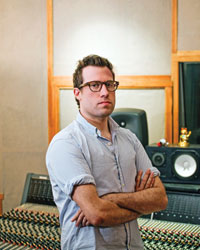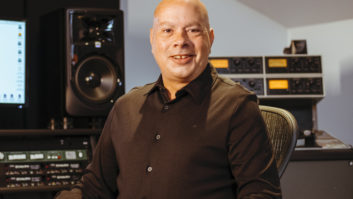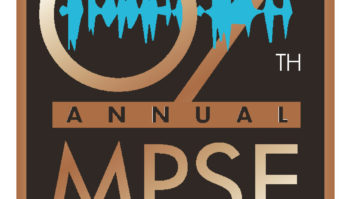
Photo: Billy Pavone
There are expectations, and then there are great expectations. The latter is what you have when your band is Passion Pit, and you have to record a sophomore album that will compare with your globe-smashing full-length debut, Manners.
Passion Pit’s unpredictable success is due at least in part to New York City producer Chris Zane, who proved adept at producing and mixing the 11 unforgettable tracks of 2009’s Manners: a bizarrely pleasing merger of cacophony, beauty, beats, keyboards, vocals and you-name-it that arrested eardrums the world over upon arrival.
For their 2012 follow-up, Gossamer, Passion Pit—led by vocalist/keyboardist Michael Angelakos—and their label Columbia Records wisely returned to Zane’s downtown sonic cauldron, Gigantic Studios. There, they hoped the band would be able to continue their magic run, and Zane likewise had the outlook to make it happen.
“When it comes to second albums, I’m staunchly against is the idea of the band completely rewriting the formula of their sound,” says Zane, whose long discography includes records for The Walkmen, Holy Ghost, Friendly Fires and Les Savy Fav. “So the idea going in for Gossamer was not to rewrite the sound of Passion Pit. It had worked, people liked it, and the last thing I wanted to do was change that.
“This is a pretty ambitious thing we tried to make,” Zane continues. “The word I’ve been using to describe the record is craftmanship. We’ve been working on this record for months. People ask, ‘Is that a real orchestra?’ Yes, it is. ‘How do you make it sound so big?’ It takes a long time!”
Zane’s philosophy of sustaining Passion Pit’s sound for Gossamer meant opening up Gigantic to Angelakos’ latest arrangements while supplying him with a huge set of tools to achieve anew what he correctly describes as their “extreme” sound.
“It takes something shocking to cut through the noise,” Zane says. “With Manners, it was the combination of drums that were both live and programmed, mixed together in a way that you couldn’t tell what was what. Then it’s the super-vibrant synths which cover everything, and of course Michael’s vocals. Those three things create an exciting sound—whether people like it or not, it captures their attention.”
One of the keys to freeing Passion Pit’s collective mind for Gossamer was the presence of more than 150 guitar pedals and over 50 analog synths at Gigantic—an avalanche of tools that provided benefits psychological as well as aesthetic. “Sometimes knowing that pedals are there makes an artist write and record differently,” Zane explains. “The way it works for us is almost sonic graffiti: Take an otherwise classic sound and put our own little mark on it. Boop. Now it’s not the classic sound, it’s a deviation. It’s the Juno patch, but going through a Wow & Flutter pedal for a detuned effect, or a little filter.

“The blessing and curse of analog pedals is that when you hear something that sounds good, you’d better press Record because you may never get it back. I think all the possibilities force us to say, ‘This sounds good. Let’s record it. Okay, next thing!’”
As Zane points out, one of Passion Pit’s distinguishing characteristics are Angelakos’ vocals, a stream of emotion, urgency, youth, confusion and aged insight that’s unforgettable from the first listen. Despite the band’s experimental nature, Zane isn’t afraid to have a system for recording Angelakos’ voice. “Nine-and-a-half out of 10 times, I use my vintage AKG C12 through a Black Face 1176, and record the vocals pretty straight up,” Zane says. “I don’t like a lot of bells and whistles going to tape. When Michael stacked his vocals, we’d use the Telefunken CU-29 ‘Copperhead’ because it took well to the sibilance.
“Compression mostly stayed the same, although I have an old tube limiter made by the Department of Commerce that was often used. It’s an extreme sound, not only because it imposes a lot of compression, but the frequency response of it is such that there’s not a lot going on above 6 kHz or below 200 Hz—so the first thing you notice is that it gets a little smaller, and second is that it’s really compressed. But other than that, the vocal stuff is more traditional on the front end, while a lot of the production comes on the back end.”
That limiter lives in a wall of gear at Gigantic that’s pretty darn big. With racks of new and vintage outboard at his disposal, supplementing the 60-channel Neve VR, mixing and music production were perfectly congealed processes for Gossamer. Working alongside engineer Alex Aldi, Zane and Angelakos recorded and mixed continuously until the day the album was officially done.
“I know it’s a cliché to say I use the studio as an instrument, so maybe a more eloquent way to put it is that the equipment used during the mix—whether used correctly or incorrectly—is a continuation of the whole process,” Zane muses. “The metaphor for how we approach a lot of the sounds is the same as theater—everything is extreme because it has to get out to the last row.
“Something Alex and I are always super-conscious of is how hard we’re hitting stuff, and making sure we’re hitting it in the sweet spot— should that be just a little harder or softer than it should be? When you’re hitting stuff too hard purposefully, there are degrees within that, and those degrees can make a huge difference. How hard you’re hitting the mix bus can vary by just one or two dBs, but it will make a world of difference—pops it up, and things just come to life. Doing it the way we like it, more often than not, means it’s running hot.”
For those who are new to Passion Pit or long-devoted fans, each song on Gossamer is a journey—12 tracks that add up to an aural voyage charted by a gifted songwriter and his adventurous producer/mixer. “A lot of the same Passion Pit DNA is there,” Zane says. “It’s just better, or louder, and more of it.”





